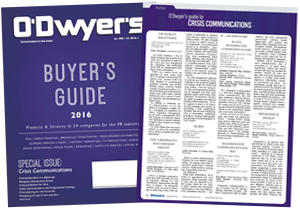|
|
When communications pros speak about managing a crisis, the discussion now often centers on speed: react quickly, get ahead of the story, quell rumors and disseminate your message without delay. While speed is always important, a thoughtful and successful crisis communications approach also requires keeping the longer-term implications of an organization’s reputation in proper focus.
A timely communications response to a crisis has always been important, but a 24/7 news cycle — coupled with the explosion of mobile, online and social media — has contributed to a “need for speed” crisis culture. As a result, emerging from a crisis with your reputation intact is more akin to a marathon than a sprint.
|
|
A crisis, however, should be seen as more than an event that demands fast action in the moment. It should be the catalyst for the development — or refinement — and execution of a reputation communications effort that will play out for weeks and months, long after the inciting event has been resolved. Though it may be tempting to let out a sigh of relief after calm has been restored, it is your post-crisis actions that can have an even greater impact on corporate reputation than the initial response. This marks the difference between damage control and honest commitment.
It’s easier said than done. The natural impetus for all involved may be to put the crisis in the rear view mirror and get back to some form of normalcy. The communications team must walk the fine line between showing the proper degree of attention without dwelling on the negative. Communicate too little and the organization might be viewed as arrogant. Communicate too much and the organization may be seen as paralyzed, wounded and backward-looking. Following are some things to consider when developing a reputation management response that strikes the right balance:
Acknowledging the problem. In this age of transparency, it’s important to acknowledge the problem and make a definitive statement that you are committed to do better. This shouldn’t be confused with accepting all of the blame. Rather, it underscores that the organization has not willfully ignored the underlying issues, and is addressing their issues thoughtfully and for the long-term. Organizations should use this opportunity to explain what processes and procedures were in place to prevent or mitigate the event, identify the apparent gaps, and give tangible direction around next steps.
Progress updates. Thoughtful people understand that the issues underlying a crisis are not solved with the wave of a magic wand. Once an organization has committed to making improvements, it is critical to make this a priority and share progress. Many organizations fall short in one or both areas, perhaps hoping their constituents will forget, or feeling that their word is good enough. A reputation-minded company will be proactive in communicating what is being done and why. You don’t have to provide every last detail, but a brief rundown on meaningful changes goes a long way toward instilling faith that your organization has taken the lessons to heart and will act responsibly.
Engagement with the affected. While a reputation management program must work broadly, special attention must be paid to those who were directly affected by a crisis situation. This might mean the community around a plant where there was a safety issue, or business customers who received a faulty product. In any of these cases, the organization must do what it can to make the communication personal. For suppliers, business partners and wholesale customers, this is usually fairly straightforward because there is a structure already in place where each relationship has an “owner.” Still, having the communication come from a more senior person — along with the relationship owner — is a wise step to convey that this is an ongoing priority for the organization.
Employees are your most important ambassadors and front line of defense in a crisis, but may also be the most cynical. Direct communication with employees is a good gesture, but executives should strongly consider going the extra mile by meeting select employees one-on-one or in small groups, sharing the feedback with senior executives, and acting on that input.
Consider a formal initiative. Some situations may call for a more formal commitment — and communication of an initiative — to demonstrate that attention is being paid. For example, a branded employee education initiative (e.g. “Safety, Security, and Success: 2016”) following a plant accident, with clearly defined, measureable objectives, and quarterly reporting to key executives.
Another good example would be a philanthropic effort that broadly relates to the reputational challenges, showing that the company is engaged and working to support solutions.
Many organizations proclaim they are “taking this very seriously” in the wake of a crisis. Those who take a longer view and focus on the right communications issues over time will be the most successful in repairing the damage done, preventing future occurrences, making progress with internal culture, and building a strong reputation.
* * *
Alex Stanton is CEO of Stanton Public Relations & Marketing, based in New York.




 There’s a fine line between newsjacking and taking advantage, aka ambulance chasing. Our job as PR professionals is to tread it carefully.
There’s a fine line between newsjacking and taking advantage, aka ambulance chasing. Our job as PR professionals is to tread it carefully. PR firms need to be mindful of ways their work product may be protected by the attorney-client privilege whenever working with a client’s internal legal team or its external legal counsel.
PR firms need to be mindful of ways their work product may be protected by the attorney-client privilege whenever working with a client’s internal legal team or its external legal counsel. Manuel Rocha, former US ambassador and intenational business advisor to LLYC, plans to plead guilty to charges that he was a secret agent for Cuba.
Manuel Rocha, former US ambassador and intenational business advisor to LLYC, plans to plead guilty to charges that he was a secret agent for Cuba. CEO mentoring is an often-overlooked aspect of why CEOs are able to make good decisions, and sometimes make bad ones—all of which intersects with the role and duties of a board.
CEO mentoring is an often-overlooked aspect of why CEOs are able to make good decisions, and sometimes make bad ones—all of which intersects with the role and duties of a board.  How organizations can anticipate, prepare and respond to crises in an increasingly complex world where a convergent landscape of global challenges, threats and risks seem to arrive at an unrelenting pace.
How organizations can anticipate, prepare and respond to crises in an increasingly complex world where a convergent landscape of global challenges, threats and risks seem to arrive at an unrelenting pace.


 Have a comment? Send it to
Have a comment? Send it to 
No comments have been submitted for this story yet.